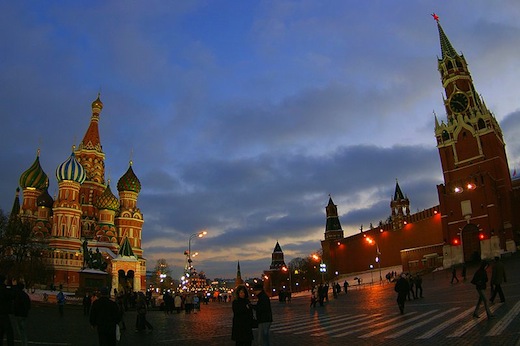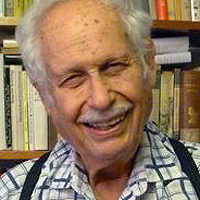
MOSCOW – I came here for a visit recently, for the first time in many years. Now the city seems engulfed by the modern world of advertising; the signs, ads and billboards sometimes remind me of Times Square.
Many offerings are of Russian make, but logos and company names are all too familiar for my taste: KFC, Subway, and the ubiquitous McDonald’s are perhaps the most intrusive.
Moscow has many beauties. I found the powerful, redbrick Kremlin with its towers more impressive than in all my recollections or television views of it. And next to it is the broad Red Square with the Lenin mausoleum and the Kremlin wall with its interred urns – among them the three American labor heroes: “Big Bill” Haywood, Charles Ruthenberg and John Reed.
New for me was the cluster of modern, curving skyscrapers, undoubtedly impressive to their owners and probably to many Muscovites as well.
Another presence that is much bigger than before the restoration of capitalism is that of the Church. Yes, before the restoration of capitalism there was the many-colored St. Basil’s Cathedral on Red Square, built for Ivan the Terrible, and the massively walled-in Novodevichy (New Maiden’s) Convent, built for Peter the Great (or for his errant sister and wife).
But other onion-shaped towers, large and small, often in shining gold, seem to have multiplied in all directions. Crowning them all is the Cathedral of Christ the Savior, the largest Orthodox church in the world, built for a series of 19th century tsars, torn down by Stalin, replaced by Khrushchev with the world’s largest out-door swimming pool, and then rebuilt for pious Christians after 1990.
But still there are islands that evoke the past. The Museum of the Great Patriotic War, an imposing, quiet new building, necessarily based on Soviet times, offered dramatic dioramas of key events during the war: Leningrad, the decisive battles of Stalingrad and Kursk, the Dnieper crossing, and the liberation of Berlin. In the dimly lit Hall of Remembrance and Sorrow countless filaments with small glass beads hung from the ceiling, symbolizing tears for the dead.
With traffic jams reaching well out into the suburbs it took our bus over seven hours to reach the city of Ivanovo, only 250 km away (about 150 mi).
A large city, the size of Miami with 400,000 inhabitants, it was once Russia’s main textile center, like Manchester in England or Lawrence and Lowell in Massachusetts. But as in so many textile cities outside Asia, the industry has died almost completely. To a visitor, Ivanovo seems a conglomerate of big, empty factories, tall apartment buildings from the Soviet era contrasting with streets lined with traditional little wooden homes, some with skilful wood carvings on eaves or windows and brief glimpses of comfortable interiors, others, hardly more than log cabins, empty and falling apart.
We finally arrived at our destination on the town’s outskirts, a complex of eight handsome buildings comprising the unusual school known as Interdom, short for “International House,” whose 80th anniversary ceremonies our mixed German, Spanish and Russian group was here to share in.
Interdom’s founding was linked with Germany, especially with the small town of Elgersburg in Thuringia. Here, in 1924, Communist Party leader Wilhelm Pieck – 25 years later the president of the German Democratic Republic – opened a “Red Aid” home for the children of people persecuted for their leftist views and actions, mostly German but also Bulgarian and Austrian. In those extremely difficult times a large number of the children were undernourished, some were rachitic, not a few had tuberculosis.
Place to learn and recuperate
This was a both a school and a place to recuperate, regain health – and keep the leftist views of their parents. Although supported by famous sponsors like Einstein, Thomas and Heinrich Mann, stage director Erwin Piscator and the artists Käthe Kollwitz, Max Liebermann and Otto Dix, pressure from the government of Thuringia increased rapidly; its Social Democratic-Communist coalition government had been driven from office by German government troops in October, 1923. And as the Nazis grew stronger and stronger the school was increasingly endangered.
The International Red Aid, abbreviated MOPR in Russia and called International Labor Defense in the U.S.), now stepped in with the offer, supported by the textile workers of Ivanovo, to replace the German school with a new one in their city. By the time the Nazis came to power this had become a dire necessity. Money was collected in the whole Soviet Union and the new school opened in the spring of 1933.
The pupils here aim at a college education when possible and are evidently better prepared than most children to get the necessary good grades in entrance examinations. But they are also given the opportunity to learn a hand-working trade; in woodworking or metal shop for the boys and designing and dressmaking for the girls. When I questioned this division I was told that the girls could also learn a trade in the shops if they wished – but I got the impression that this was hardly common if at all the case. This seemed an echo of the thinking of past years – or perhaps of present Russian reality.
The evening of May Day featured an outdoor picnic outside the gym and swimming pool. There was sack racing, bowling – with a basketball and big soda bottles as pegs, throwing baskets, hopping on one leg and trying to push the opponent off balance, walking a straight line backwards using a mirror, skipping rope and tug of war, hop scotch and walking blind-folded a slalom line between pegs. I was most affected by the happy, natural atmosphere, with never a cross word between older and younger pupils, white and black, Russian and Chechen, boys and girls.
I must be very cautious in generalizing. I could be mistaken in my vivid admiration of this school. Yet another thought crossed my mind. Was this an isolated island, far removed from the facts of modern life? In some ways it recalled the innocent ways of long past, perhaps never really existent “school days”; no television, and hand phones -only once did I see a boy playing an electronic game on his hand-held phone.
No coke or any other vending machines, no smoking on the grounds, no racism or sexism (unless the choice of trades could be so labeled). No commercialism and no demonstrative religion; I was told that pupils could practice any religion they desired, but the school itself was completely secular.
Of course no guns were to be seen anywhere. But perhaps most interesting: no rejection of the Soviet past, which had provided, after all, the foundation for this school. Can one live properly on such an island? And should one? And will these youngsters adjust later, after arriving in the outside world?










